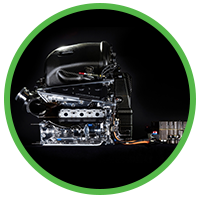
The main traction inverter converts DC current provided by the high voltage battery of the car, into AC current required by the induction motor responsible for producing the torque required to propel the vehicle. Performance of this module significantly contributes to the overall efficiency of the vehicle, in terms of its acceleration and driving range. Both conduction and switching losses must be carefully evaluated when selecting the required power electronics components of the inverter module, in order to achieve the vehicle's targeted drivetrain performance.
These inverters usually contain high-voltage battery systems of either 400 V (HVL1) or 800 V (HVL2), the latter becoming more popular in the latest designs. These systems require power semiconductor devices rated either in the 600 – 750 V range, or 900 – 1200 V range, corresponding to HVL1 or HVL2. Power inverters are required to operate at current levels in the 400 – 1000 A range, per phase. In order to achieve this, some manufacturers use parallel combinations of discretely package devices, while the majority use power integrated modules (PIM).
Additionally, challenges in the mechanical construction and assembly of the module have opened the door to different levels of integration for the power electronics components, going from a wide variety of discrete IGBT and MOSFET packages, to full module integration in the form of half-bridge and three-phase bridge configurations using Al2O3 (Alumina) or AlN (Aluminum Nitride) substrates, giving customers several ways to solve all of the assembly and thermal difficulties of this challenging design.
With the launch of VE-Trac Traction inverter solutions. ON Semiconductor aims to enable three design platforms: VE-Trac Chip for customized packages, VE-Trac Dual for high power density scalable inverter solutions, and VE-Trac Direct for quick product deployment based on widely adopted industry footprints.
Future devices in the VE-Trac™ family will include discrete power devices, Isolated gate drivers and expanded module solutions, as well as wide bandgap (WBG) devices that will drive performance and expand the portfolio of products available to automotive systems designers.
Read more: Details


